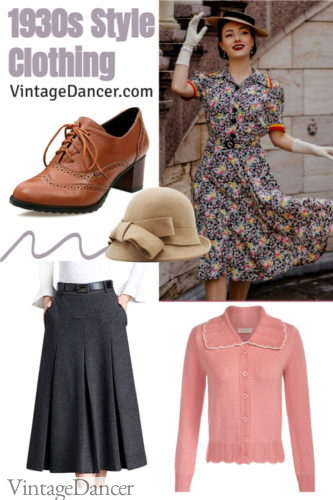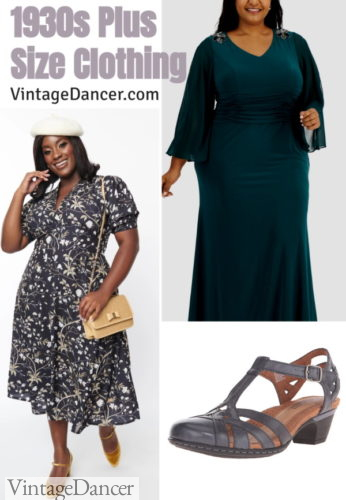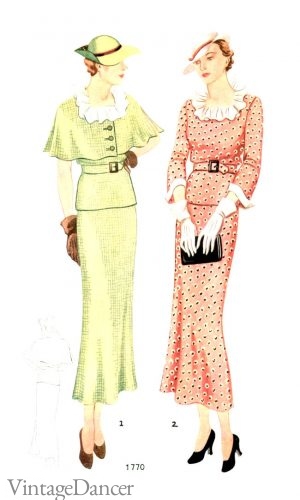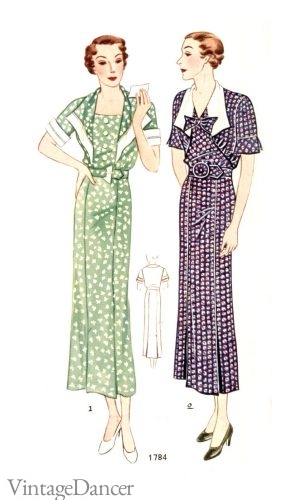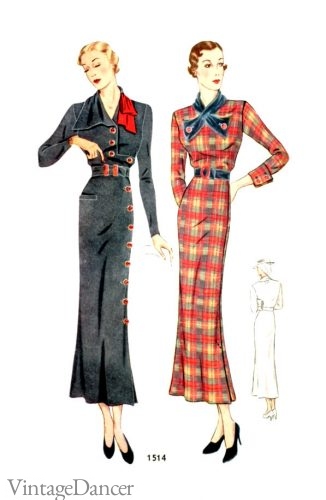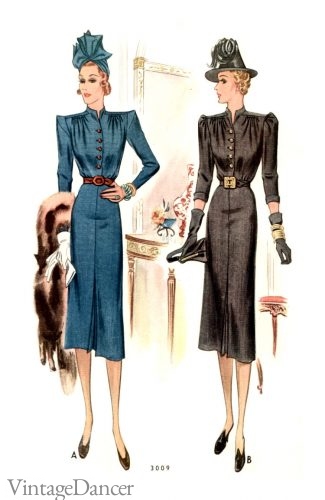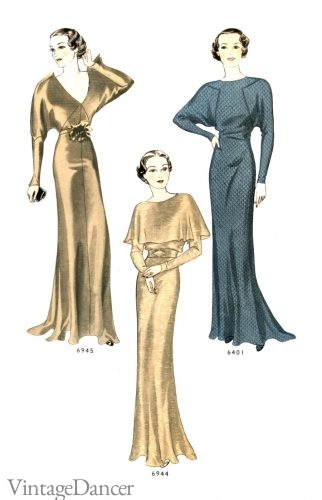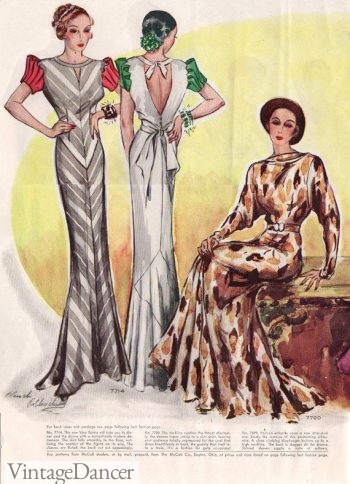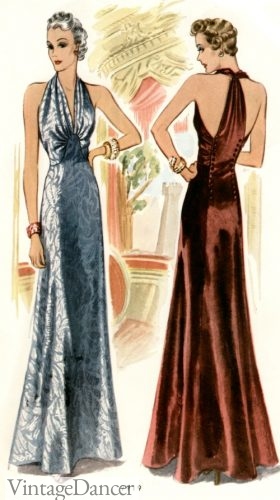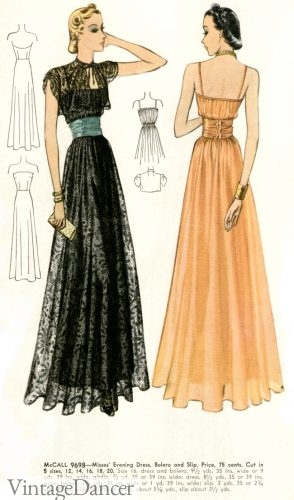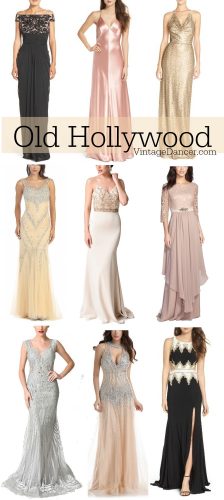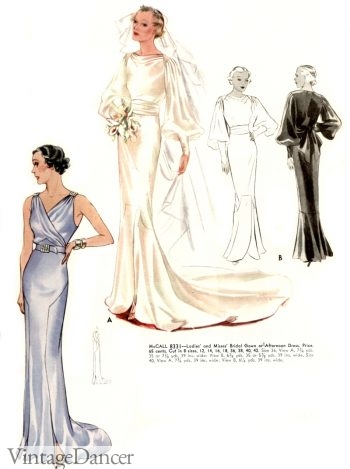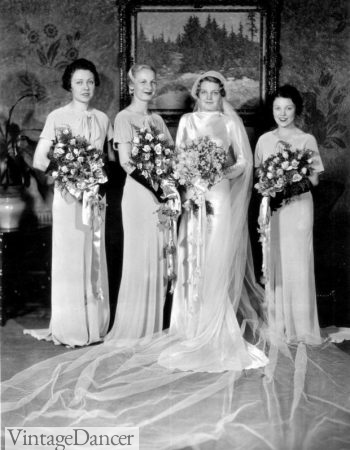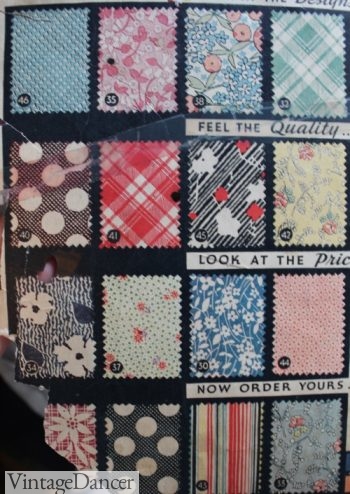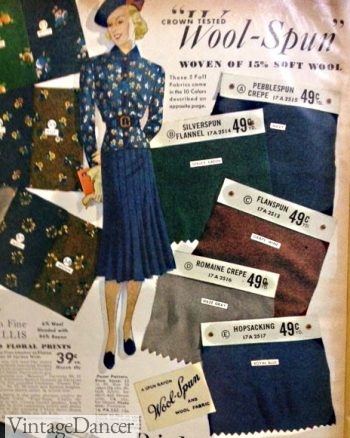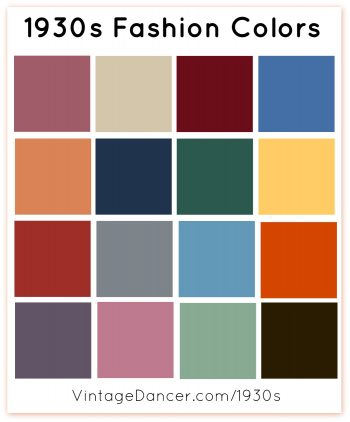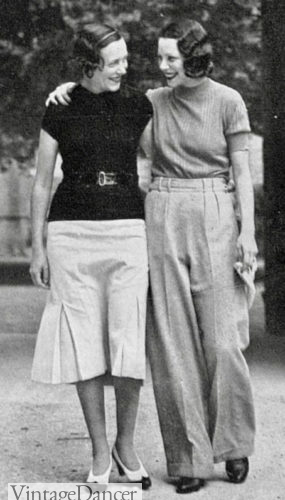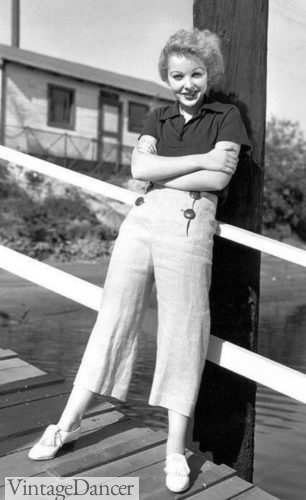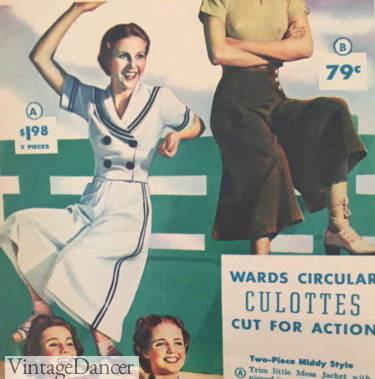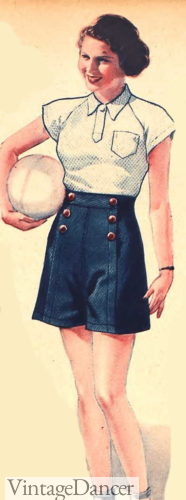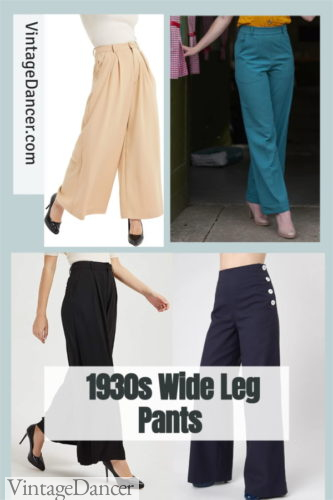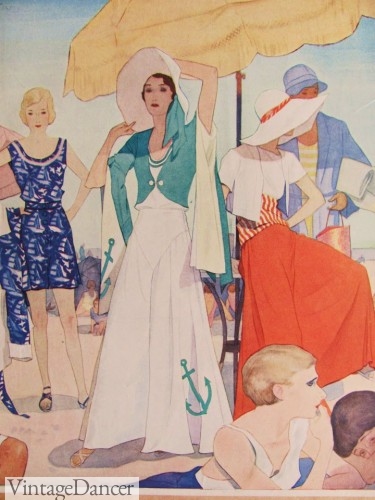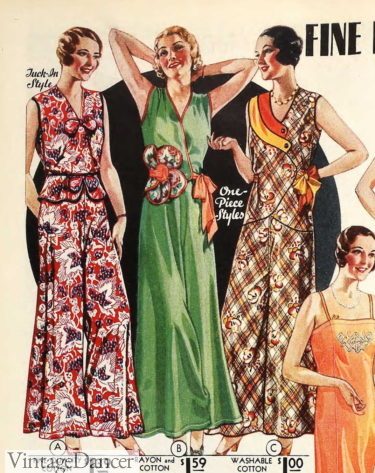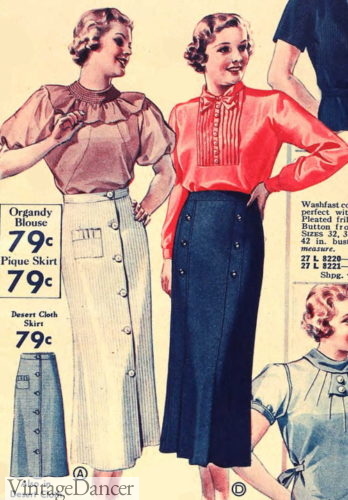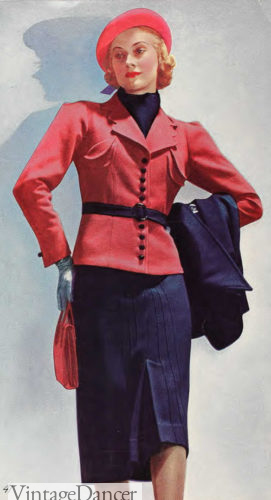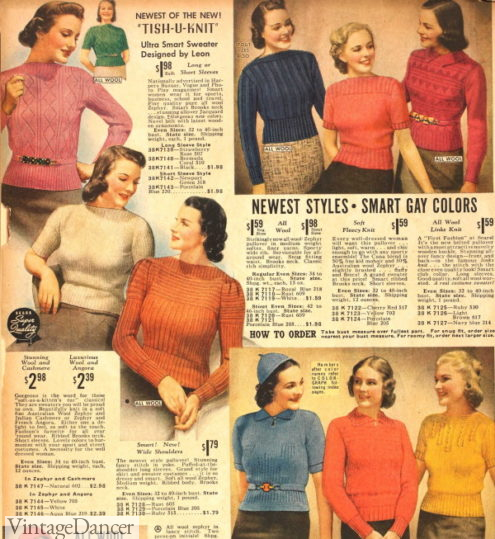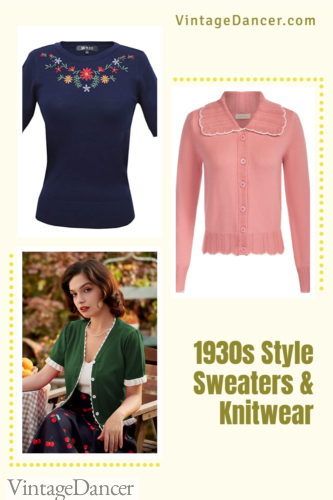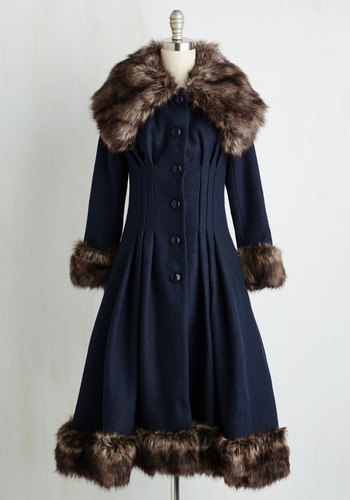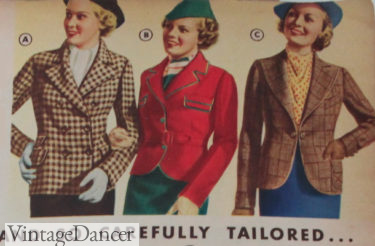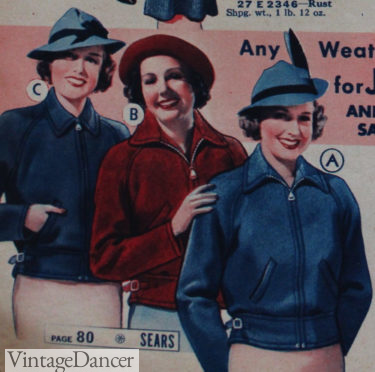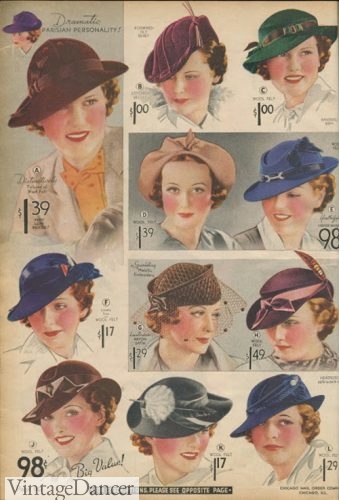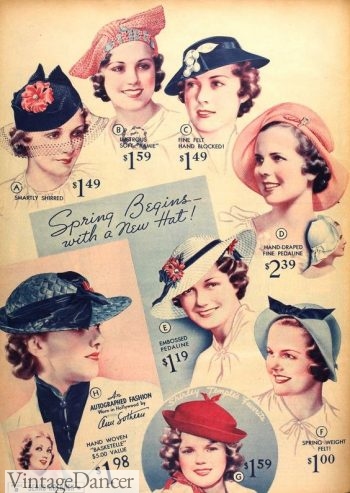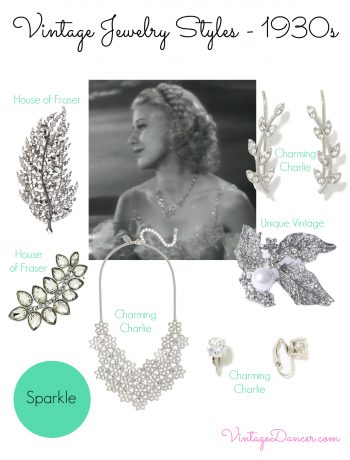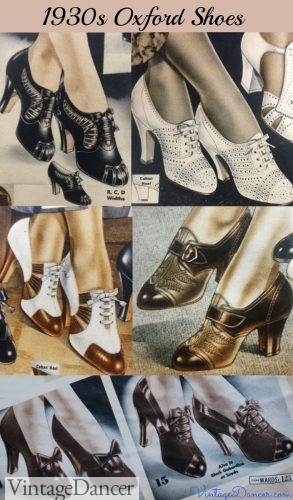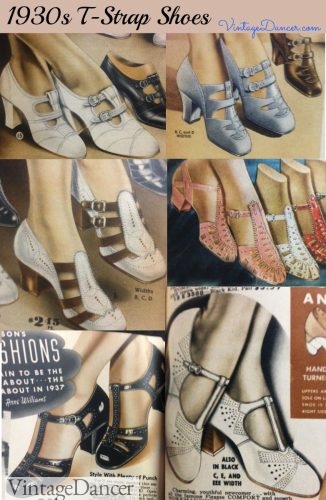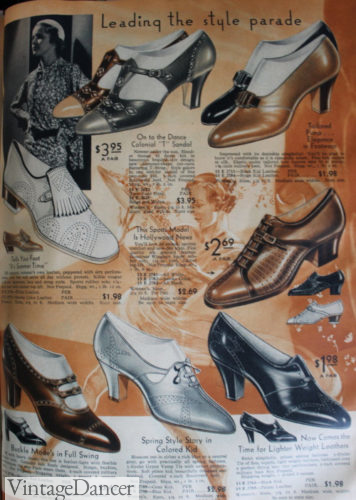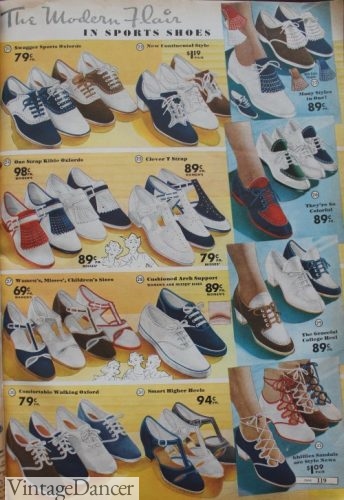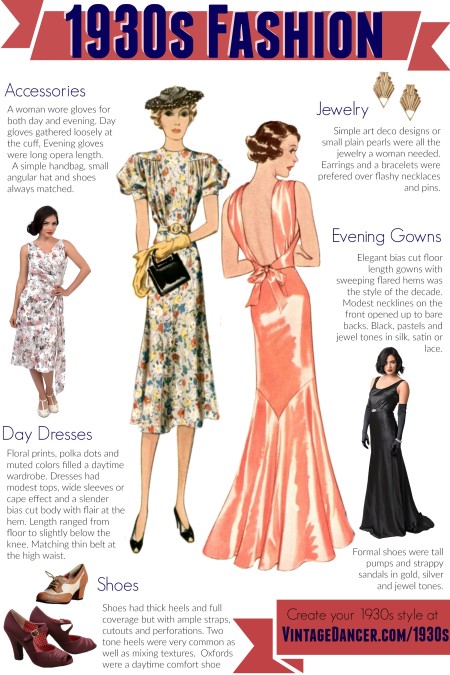
1930s fashion for women quick guide.
What did women wear in the 1930s? Women’s 1930s fashion is usually overshadowed by the sorrow of the Great Depression, but the 1930s were full of glamour and style.
Welcome to the glamorous, elegant, well-tailored world of women’s 1930s fashion!
1930s Fashion Trends – What was the fashion during the 1930s?
- Midi length bias-cut dresses, puff sleeves, belted waists, and large yokes, ruffles, pleats and collars
- Old Hollywood evening gowns – backless, sleeveless, long bias-cut dresses.
- High waisted sailor pants and wide leg beach pajamas.
- Casual sports clothes — skirt-like shorts, striped knit shirts.
- Slouch hats, tilt hats, knit berets.
- Fur collar winter coats.
- Oxford shoes with perforated details and evening T-strap heels.
- White accessories – gloves, belts, hats, shoes
In this article you will learn about all the 1930s clothing and accessories women wore for day and evening events. You will also be able to create a 1930s wardrobe from vintage or new inspired clothes we found online (follow the links) or start here.
Dresses | Shoes | Pants | Tops | Skirts | Coats | Hats | Gloves
1930s Fashion History
What was the women’s fashion during the 1930s?

Floral Dresses in the Typical Early 1930s Silhouette
The very loose, square, drop-waist, high knee-length hem and slightly “boyish” look of 1920s fashion for women was completely gone by 1933.
The boxy 20s look was replaced with a much more modest and form-fitting 1930s style with an accentuated natural “high waist,” fitted hips, longer mid-calf or floor length hemline, high neckline, and wide shoulders. Trim, tailored, modest, and feminine describes women’s 1930s fashion perfectly.
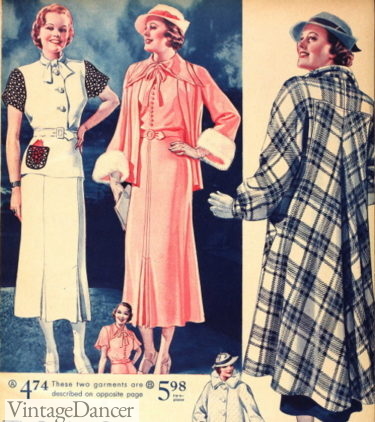
1936 Fashion for Women
The ideal ’30s woman’s figure was tall and slender with a very small waist and narrow hips. Since most women were not blessed with slim hips and narrow waists, shoulders were exaggerated with puff sleeves, shoulder pads, large collars, caplets, and butterfly or ruffled cap sleeves, all of which made waists and hips appear smaller in comparison.
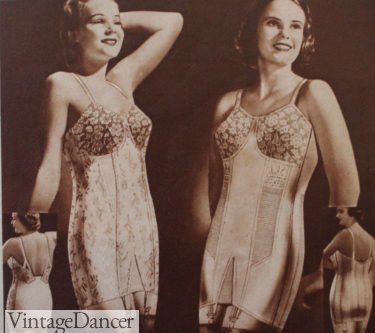
1938 Lasttix Corselets
1930s lingerie also helped shape women into slender tubes with a defined bust. Most clothing shop ads and catalogs featured artistically drawn women who were three times as tall and thin as any real woman could be. The ideal 30s silhouette was anything but realistic.
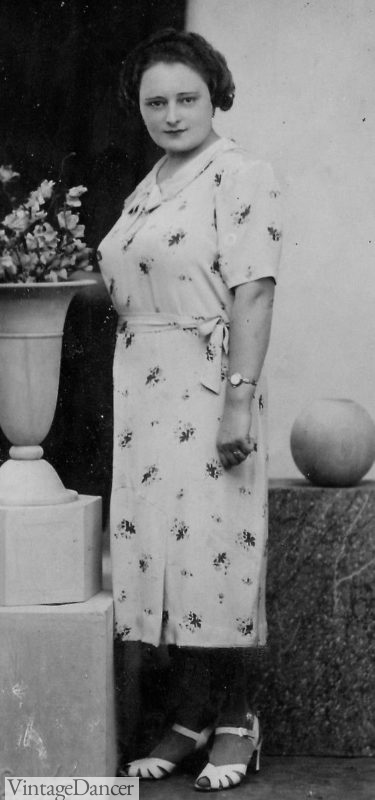
1930s Floral Dress for a Plus Size Woman
How did real women dress in the 1930s? See pictures of average to plus size and young to mature women here.
The fashion industry underwent many changes during this decade in response to the severe economic hardships of the time. Factory-made garments (what we now refer to as “ready-to-wear”) became popular because clothing could be mass produced for far less than made-to-order custom garments.
The insurgence of ready-to-wear fueled the ‘buy at home’ catalog market such as Sears, Montgomery Wards, and Simpsons. Small town local shops carried a simple selection of cotton house dresses, hats, stockings and accessories – cheap items for low budget shoppers. Many stores also resold used items and churches had donation bins in the basements for the poorest folks.
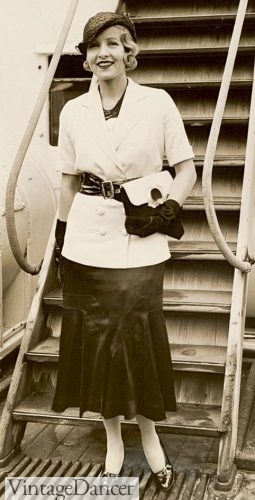
1932 Outfit
During this era, zippers became a staple in finishing a garment – they cost less than buttons! Less expensive fabrics, “rough” or “peasant” fabrics, and cotton became more widely used. In fact, nubby, textured, crepe, or crinkled “rough” fabrics became a trend — “The rougher the smarter!” declared one catalog, particularly for day dresses, skirts and coats.
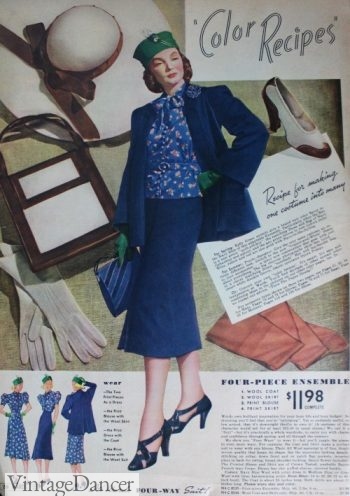
1938 Fashion and Accessories
Being on a tight budget was no excuse for sloppy fashion. It was considered a woman’s duty to shop smart and look “smart” by wearing the latest 1930s fashions, materials, and designs she could afford. The frugal woman who could feed and dress her family on a dime was praised. She was considered a good steward of her husband’s money! Such was the life of a 1930s wife.
Single and working women, too, were expected to look their best– to be appealing to their male employers. Despite the Depression, makeup and cosmetics sales doubled in the thirties!
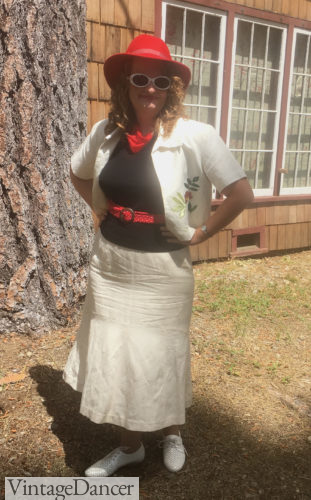
My 30s Summer Outfit – All from Thrifted Clothing
1930s Fashion: House Dresses
The most casual a woman dressed was while at home, with just her family, or when visiting lady neighbors. House dresses, while basic and usually made of practical durable cotton, followed the trends in cut and silhouette, and often displayed a variety of bright bold prints.
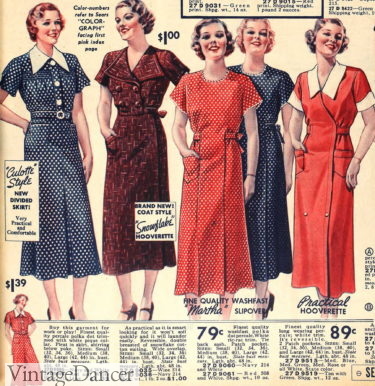
1936 House Dresses/ Day Dresses
Most women still preferred to sew their own clothing or upcycle existing dresses into newer frocks. When flour was delivered in pretty fabric bags, women used these to make new dresses and aprons. The house dress was the ideal dress to experiment with, since no one but family saw her in it.
Shop 1930s sewing patterns here.
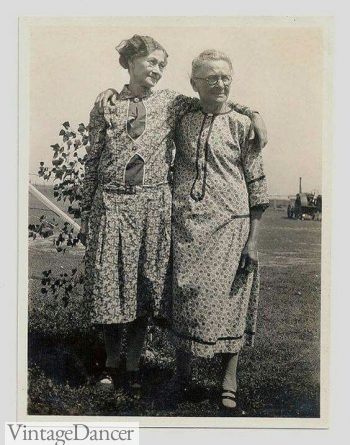
Flour Sack Dresses
One unique house dress variation was the reversible house wrap dress, called a “hooverette.” Practical, affordable, and washable in cotton percale, they were true to thirties style. Sporting ruffle sleeves, an accentuated tie waist, and a slim cut through the hips, the “hooverette” was the perfect daily dress. With two sides, it was two dresses in one! Now that is a smart woman.
Read more about 1930s house dresses.
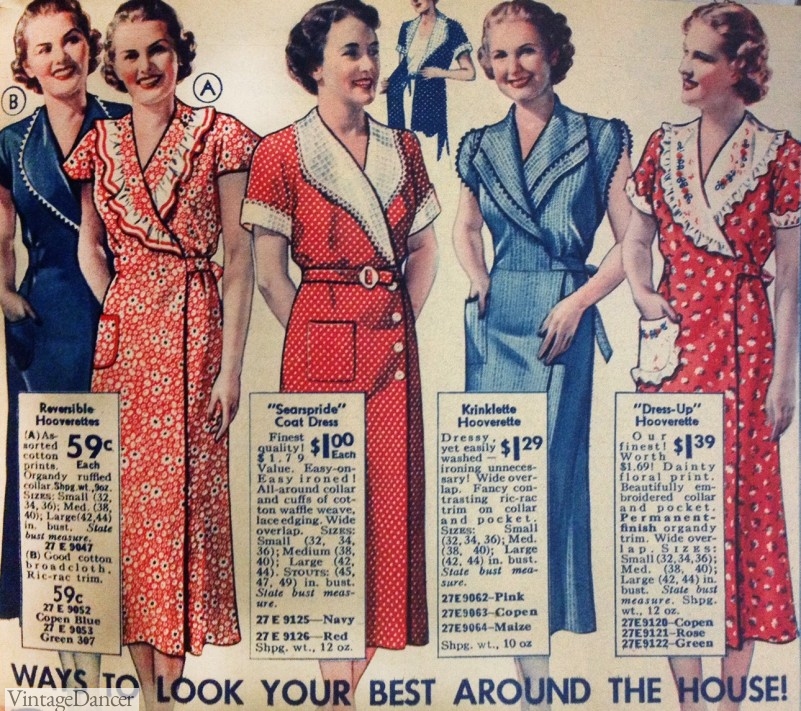
Hooverette House Dresses
1930s Fashion: Afternoon Dresses
A 1930s woman would not wear her housedress out of the house. To shop, run errands, attend a tea, or see a matinee, she would need a 1930s smart afternoon or day dress. Often referred to as “city,” “metropolitan,” or “town tailored,” these dresses were usually silk or rayon crepe, not cotton. They had the standard silhouette and classic ’30s features: puff sleeves, belted waists, and large yokes and collars.
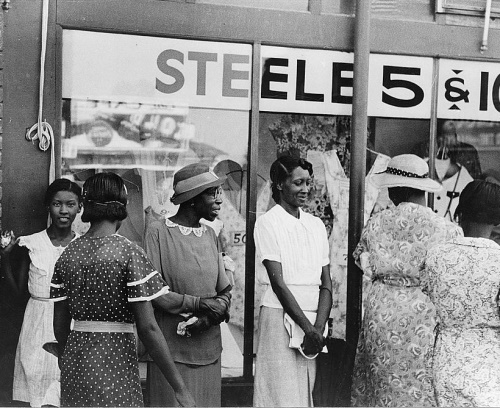
1938 Women at a Five and Dim Shop, Shopping After Church
These dresses had more embellishment and detail than a house dress: embroidery, covered decorative buttons, shirring and ruching, bows, trapunto, and faux flower trimming were part of the array of details added to make a dress smarter for forays outside the house. 1930s dresses tended to be solid colors or more subdued prints. Most dresses came with a matching belt placed slightly above the mid-waist.
- Tunic Top Dresses
- 1930s Summer Dresses
- Long Dresses
- Late 30s Dresses
Shop 1930s inspired day and afternoon dresses here.
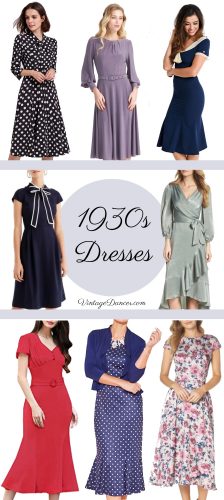
1930s Style Dresses – Shop Here
1930s Evening Gowns
Silky, clinging fabrics were common in 1930s evening gowns, often worn with a fur wrap or coat. Fabrics that were popular included chiffon, silk, crepe de chine, and satin, all cut on the bias to create elegant flowing lines. Metallic lamé came into fashion as well. Evening dresses had hems that very nearly touched the floor and often had small trains in the back.
- Slinky 30s Evening Gowns
- 30s Patterned Evening Dresses
- 1930s Backless Evening Gowns
- Sheer Net Evening Gown
Evening dresses were also very fitted in the waist, slim and fitted through the hips, and eased out mid-thigh or just above the knees, where they flared elegantly to the floor. There were gowns with puffs and ruffle sleeves, and later in the decade high necks and halter styles with plunging backs were in fashion. The backless gown is a signature of 1930s evening wear.
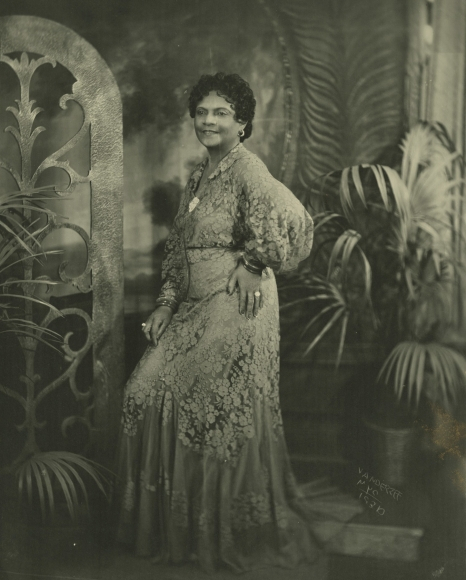
1936 – This Dress is a Peach Color, Popular for Eveningwear in the Mid 1930s
Nearly all modern formal gowns have their stylish roots back to the 1930s. Old Hollywood stars of the Golden Years remain icons for glamour on the runway. This year, many current Hollywood stars chose to wear 1930s inspired gowns on the red carpet. It is a style that is a classic favorite in any decade. Learn more about 1930s evening gowns and party dresses and accessories.
Shop new 1930s Evening Gowns and Dresses.
1930s Wedding Dresses
Afternoon and evening dress fashions were turned into 1930s wedding dresses. Informal light floral tea dresses with excessive ruffles and butterfly sleeves started off the 1930s.
Next came bias cut dress with a modest high neck, long sleeves, and floor length gown with a fishtail train made of silk or shiny satin. They paired with very long lace trim veils cascading down the back to church aisle. In the last few years, dresses took inspiration from the turn of the century with large mutton sleeves and a full skirt.
Learn about 1930s weddings and shop 1930s style wedding dresses.
- Bias Wedding Gown
- 1930s Wedding Party
1930s Fashion Fabric and Colors
What fabric was used in the 1930s? Primarily cotton broadcloth for day dresses. Silk or rayon crepe was seen for afternoon frocks, and sheer rayons for blouses and summer party dresses. Linen was used for summer suits and dresses, and wool for winter suits and outerwear. Rayon tweed or corduroy was seen in fall/winter dresses as well. For evening gowns, there were silky satin, lace, velvet, and taffeta.
- Mid 1930s Fabric Swatches
- Wool Fabrics
1930s fashion colors were lovely pastels in spring and summer and rich earth tones in fall-winter. Peach and aqua were new favorite warm season colors not seen in the ’20s. In fall, burgundy/maroon made a reappearance. The 1930s were a colorful time, and there was almost no color left out.
Read more about 1930s fashions colors and fabrics here.
1930s Women’s Pants / Trousers
While rebellious women began wearing pants / trousers/ slacks in earlier decades, in the 1930s there were several social situations that were acceptable for women to wear pants in public.
Sportswear for tennis, hiking, picnics, skiing, or even just watching sports featured trouser pants, overalls, and even shorts! The sailor inspired two-piece “sailor middy” was a common sportswear outfit.
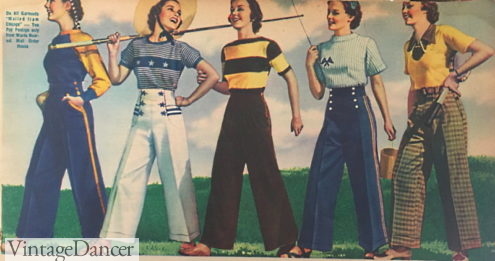
1937 casual slacks and knit tops
- 1933 casual pants and knit top or skirt with knit top and belt
- 1930 Linen Culottes with Sailor Buttons
Women’s 1930s pants generally were wide legged trousers with a front crease or very wide flowing culottes that looked like a skirt when not moving, with a high fitted waist. Calf length culottes pants were even wider legged.
- 1937 Summer Culottes
- 1937 sailor shorts and polo shirt
Similarly women’s 1930s shorts had a skirt-like look with wide pleated legs or came in the same sailor button looks as pants. Learn more about women’s 1930s shorts, rompers, playsuits and summer clothes.
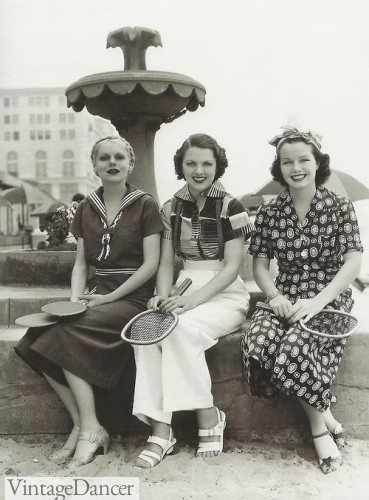
1936 Actresses Carol Hughes, Marie Wilson and June Travis wearing culottes and suspender slacks
The double button “sailor” front was common in 1930s fashion ads, as was a side zipper or button closure. They were usually made of a durable cotton fabric like twill or wool for winter.
Learn more about women’s 1930s slacks, pants, overalls, culottes, and riding outfits.
Did women wear jeans in the 1930s? Yes and no. Denim blue jeans were mostly a men’s working class item. Women wore some jeans out in the wild west, for horse back riding, vacationing at a dude ranch, or tending to a garden. Some overalls, pants and shirts were made of light chambrey denim for leisurewear. Learn more about 1930s blue jeans and western wear history.
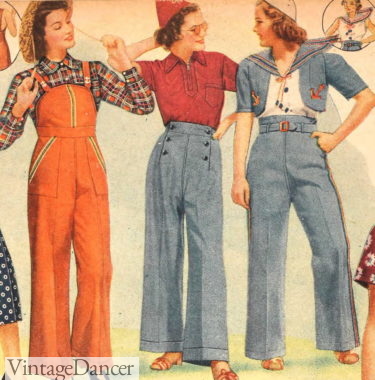
1938 denim overalls and pants
In summer, 1930s beach pajamas, which looked like palazzo pants with an attached sleeveless top, graced the beaches, seasides, and pools of 1930s Hollywood. They were made to comically extreme widths and in bold geometric patterns, but were (and still are) extremely comfortable to wear. Beach pajamas became popular for a day at the beach or a “restful day at home.”
- 1930s Beach Pajamas
- 1931 House Pajamas or Beach Pajamas
Beach pajamas were also house pajamas along with silky nightgowns, robes and slippers. Learn more about and shop 1930s women’s sleepwear.
Shop 1930s style wide leg pants and beach pajamas.
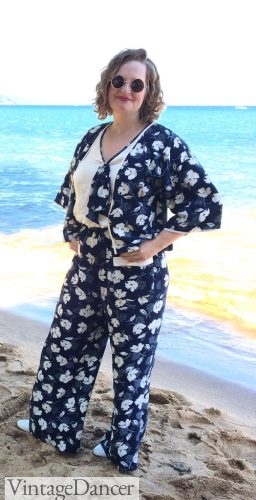
30s Beach Pajamas by House of Foxy
1930s Skirts and Suits
A more common option for separates was the tailored skirt. At first, the ankle-length hanky hem skirt set a softer tone to the start of the ’30s. Ruffled skirts were replaced by the long column skirt in the mid-30s that gradually shortened up into the flared skirt just below the knee in the late 30s. Skirts had a very high waist, a slim but not tight fit, and a bit of a flare at the hem. Gores gave some skirts a wider fit, as did narrow pleats.
Skirts sold with matching or coordinating jackets became suits. Suits jackets were short, with wide lapels and a slim tailored fit.
- 1936 Skirts and Blouses
- 1937 Red Blazer Jacket Suit
Blouses and Sweaters
Paired with pants and skirts was an array of blouses and sweaters. The floral print cotton button-down blouse was an all-time favorite for its simplicity and comfort. Booth summer and winter blouses fit short and snug around the waist to allow for high rise pants and skirts. Short sleeves were puffed. Necklines were very modest with small collars in a variety of charming shapes. Decorative details such as shirring, pintucks, ruffles, and contrasting buttons gave them a delicate, girly, and playful aesthetic.
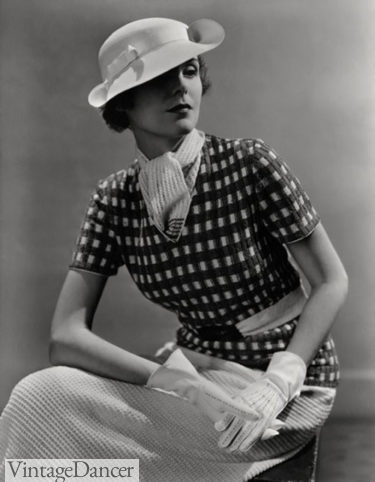
A V-Neck Knit Top with a Knit Scarf Tucked Under
If a blouse had a lower neckline, a silk or light knit scarf could be tied around the neck and tucked under the blouse. It was very posh to do so!
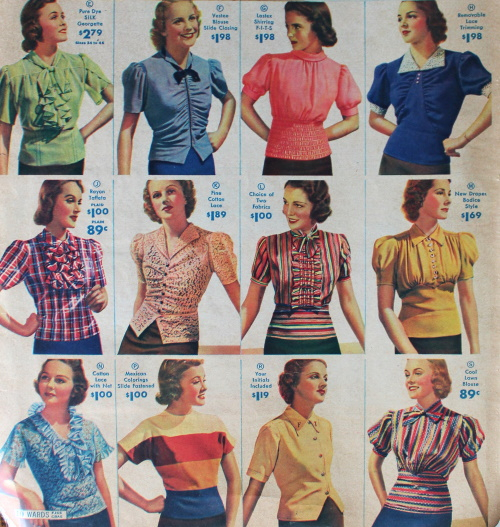
1938 Short Sleeved Blouses
Almost any fitted blouse with a modest neckline can work for a 1930s outfit. A few possible blouses or tops are:
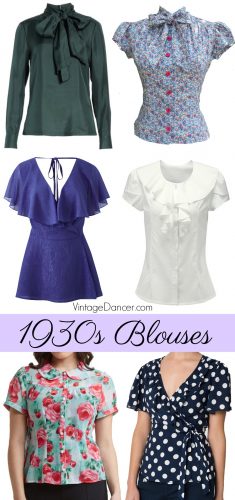
1930s Style Blouses – Bows, Wraps, Ruffles, and More
The most basic blouse was a button-down shirt with a classic point collar in white or other seasonal colors. The white blouse paired well with suits, skirt separates, and summer trousers. It could be both casual and dressy. Other popular patterns were polka dots, plaid, stripes, and paisley. Print blouses were often sold with a matching dress jacket lined in the same material, along with a coordinating skirt.
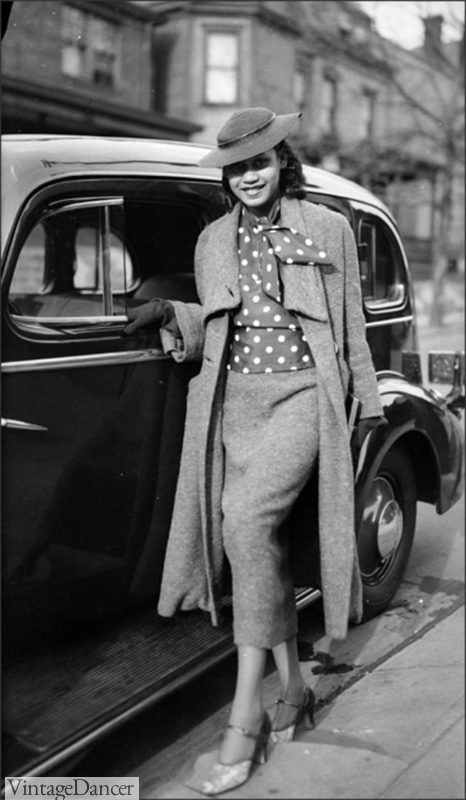
Ensemble of a Tweed Coat and Skirt, Polka Dot Blouse, Plate Hat, and Mary Jane Heels
For fancier dresses, the long sleeve dolman sleeve, bishop sleeve, or wrapover blouse with a fitted waistband exaggerated the top. Oversized bows, flounces, ruffles, capes, and dickies also added volume to silk, lace, organdy or satin blouses. Shirring around the shoulders and bust amplified the bust area. Many dressy blouses came with a matching belt. Fun by day, drama at night.
Shop 30s style tops and blouses.
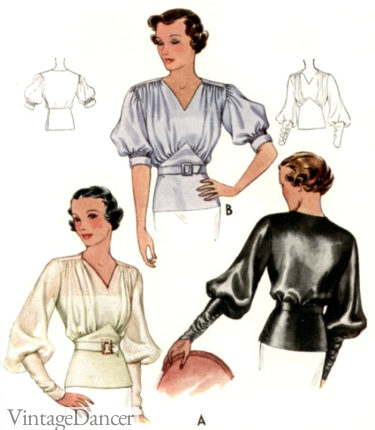
1930s blouses with bishop sleeves
For casual affairs, the knit top, especially with nautical themes, looked best with wide-leg pants and flared shorts. Many knit tops in the polo shirt style had collars and ties, while others had modest round necklines with a fitted waist (early T-shirt style). Casual tops were worn untucked. Many had zip up or button up plaquettes.
Learn more about 1930s blouses and knit shirts.
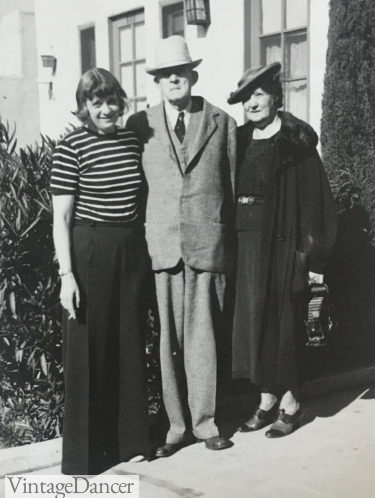
Woman on the Left Wears a Striped Ringer T-Shirt with Wide Leg Pants
Cardigan and pullover sweaters were also slim fitting, accentuating the narrow waist and flat hips. Sweaters could be both short or long sleeves, worn on their own or layered over another blouse or camisole. Necklines were very high and sleeves fitted down to the wrist. There were a variety of small textures and weaves as well as simple decorations such as tassel ties, ribbon flowers, and contrasting buttons.
Learn more about 1930s sweaters, cardigans and knitwear history.
Shop 30s style sweaters and cardigans.
Swimsuits and Beach Clothes
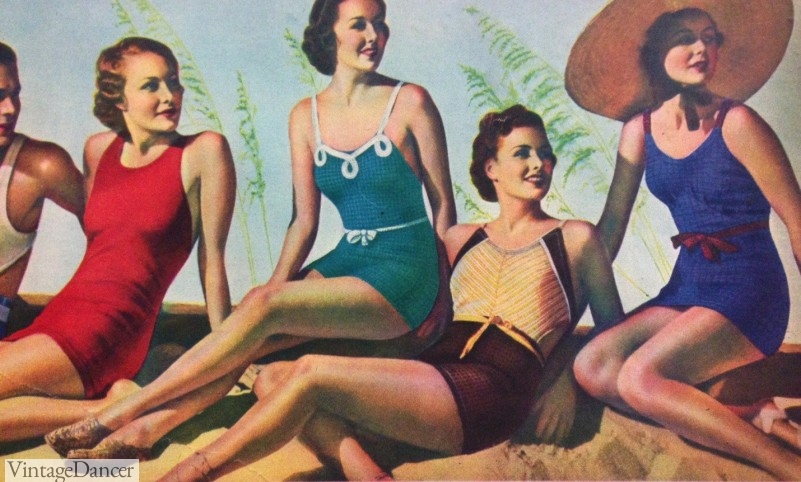
1934 Swimsuits
In addition to beach pajamas, women’s swimwear consisted of fitted wool one pieces with cotton jersey lining, a mini skit over boy shorts, and frequently little belts accentuating the waist. Usually, they had simple tank straps and often low or even plunging backs.
Sunbathing became a trend in the 1920s and continued in the ’30s as Coco Chanel and Hollywood stars encouraged the tan look. A tan began to mean that one had time for leisure, not that one had to work in the sun.
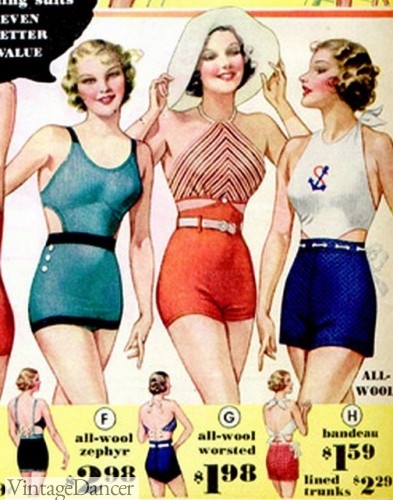
Wool Swimsuit and Floppy Sun Hat
Some concern for too much sun started in the ’30s. Hollywood stars quickly adopted large sun hats and sunglasses into their beachside wardrobe. Open toe sandals, too, were becoming more common for beachside strolls. Even if a woman lived hundreds of miles from the ocean, she still dressed liked she was on vacation in California.
Learn more about 1930s swimwear history and shop retro vintage inspired 1930s swimsuits.
1930s Coats and Jackets
Following dress style, women’s winter coats went to mid calf with a nipped high waist, full shoulders, puffed sleeves, and wide lapels or oversized collars and made entirely of wool. Many, such as the green coat below, had large detachable fur collars. Most coats buttoned up the front or off-center, and some also had matching belts. Colors were rich but cheerful green, medium blue, wine, brown and cream.
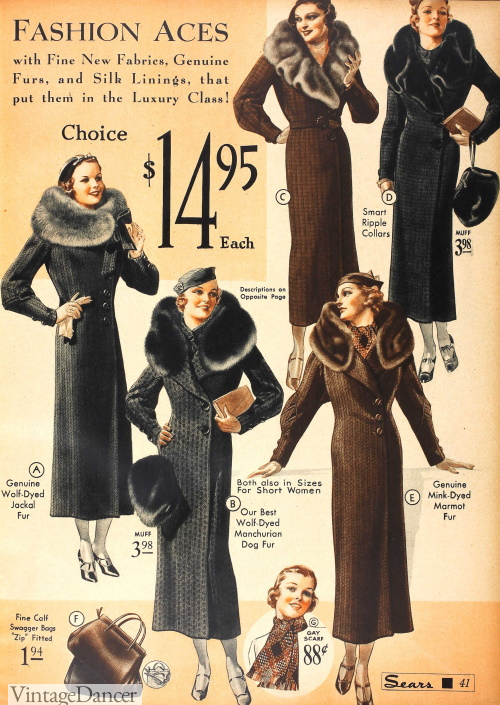
1935 Fur Collar Coats (Round and High)
Raincoats mimicked the shape of fashion coats. The trench coat and the cape coat was especially popular. While wool did a good job of repelling water naturally, raincoats were coated in a type of rubber or made entirely of rubber. Clear raincoats were a new trend that women appreciated, since it did not cover up their beautiful clothes underneath.
Learn more about vintage raincoats from the 1920s to 1950s.
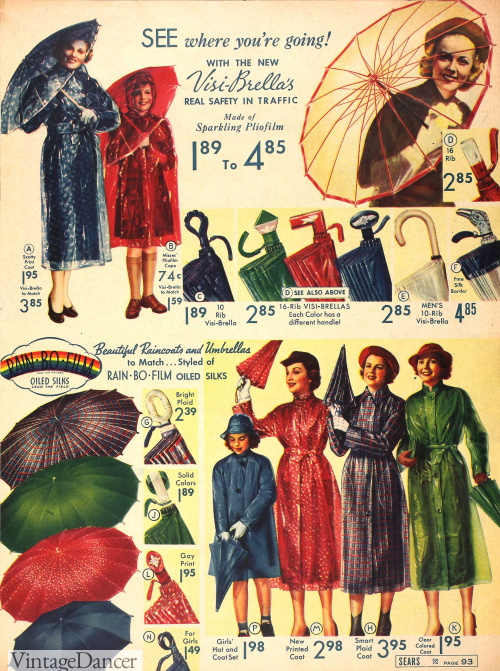
1937 clear colored rainwear
In the late 30s, casual jackets became the trendy thing to wear with a tailored skirt and blouse instead of a matching suit jacket. They look a bit like blazers made of wool or velvet with a single or double-breasted front. Many had bold patterns or very bright colors such as red, blue, or green.
- Blazer Style Jackets
- 1937 Cossack Jackets
The most casual of the new jackets was the cossack style jacket (bomber jacket), which was a direct copy from menswear. It came in wool but also leather and artificial leather. There was also the military-inspired leather flight jacket dyed in vibrant colors. Women loved these short jackets so much that they often purchased men’s jackets instead of waiting for the fashion industry to catch on. Learn more 1930s Coats and Jackets History
Shop for 1930s style women’s coats and jackets.
1930s Fashion Accessories
Accessories were very important to the cash-strapped 1930s woman. Accessories could transform a simple dress into something very smart. As the decade progressed and the worst of the Depression passed, matching belt, glove, and bags sets (as well as belts dyed to match a dress exactly) became popular.
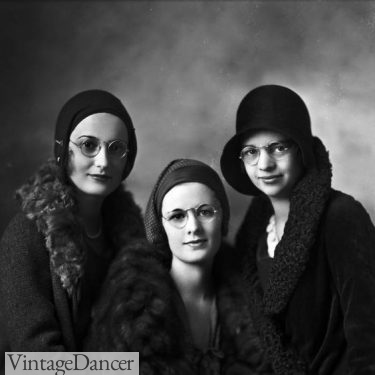
Early 30s Slouch and Cloche Hats
Hats became a primary method to glam up an ensemble. A wide variety of hats were worn in the ’30s. The ’20s cloche and the beret lingered on from the previous decade. The cloche evolved into the “slouch” hat, still worn low on the face but with much more of a brim, worn turned up on the forehead.
Small hats worn at a tilt often with a single feather as an accent dominated the decade. Small white straw hats were worn in the summer, as well as wide-brimmed cartwheel hats. Menswear style fedora hats dominated the late 30s. Learn about 1930s hats.
- Mid 1930s Hats
- Late 1930s Day Hats
For bad hair days, wearing a pretty scarf tied over the head and under the chin like a kerchief was a charming way to keep fashionable.
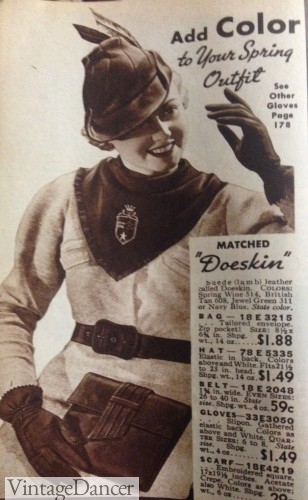
1937 Matching Gloves, Bag, and Belt
Bags tended to be small flat clutches or “pochettes,” and evening bags often had jeweled clasps. Bags got a little larger with handles as the decade wore on. Read more about 1930s purses.
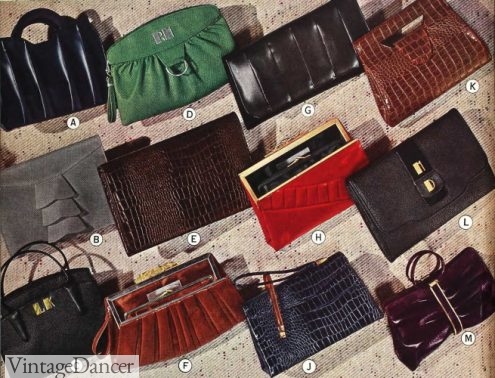
1936 Flat Handbags
Gloves were worn with both day dresses and evening gowns. Daytime gloves were mid arm length, gauntlet styles in fabric, crochet lace or soft leather. Gauntlet style gloves had flaring cuffs attached at the wrist or embroidered turn-over cuffs. Elbow-length gloves were still worn for some evening gowns, but bare arms were preferred. There was a strict etiquette for what type of gloves to wear when and with what dress. Learn more about gloves here or shop vintage style gloves here.
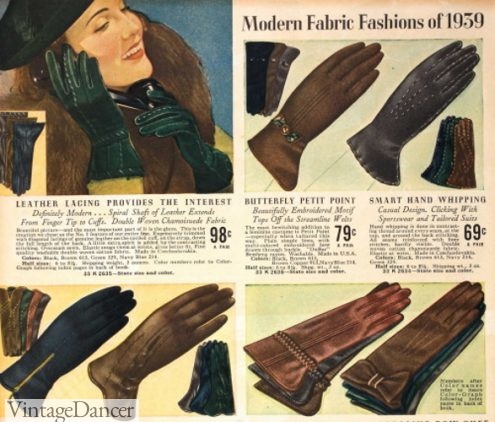
1938 Women’s Fall and Winter Gloves
Jewelry was very important in the 1930s. Budgets were small, however, so many women had to make their own accessories. A small cluster of flowers was a perfect brooch for a lady’s suit. Colored glass beads mimicked pearls but cost significantly less. Rhinestones were cheap and sparkly so naturally, they were made into dress clips, pins, earrings, bracelets and evening necklaces. Read more about the variety of 1930s jewelry styles and shop 1930s Art Deco inspired jewelry and accessories.
1930s Shoes
Women’s shoes in the 1930s came in a wide variety of styles, but walking Oxfords were extremely popular. Shoes with cutouts such as pumps, T-straps, ankle straps, low heel flats, and sandals were everywhere. Cutouts and broguing (small holes) are unique characteristics of a 1930s era shoe.
Pumps were made in patent leather or suede and had square heels, with a variety of decorative details like lacing, removable tongues or bows, and top stitching. Toward the end of the decade, wedges began to appear. The T-strap shoe that began in the ’20s exploded in the 1930s in both casual and dressy styles.
- 1930s Oxford Shoes
- 1930s T Strap Shoes – Single Strap, Two-Strap, Multi Strap
- 1937 Dressy Heels
- 1937 Sporty Shoes
Common shoe colors were brown or black for winter and white for summer. Two-tone spectator pumps were also on-trend, as well as two-tone sports shoes like the saddle Oxford. For evenings, the dancing sandal was a strappy high heeled pump in silver or gold. In winter, women wore fur-lined boots and rain galoshes.
Shop 1930s inspired shoes here.
If you need flat shoes look at these, and for wide or narrow shoes look here.
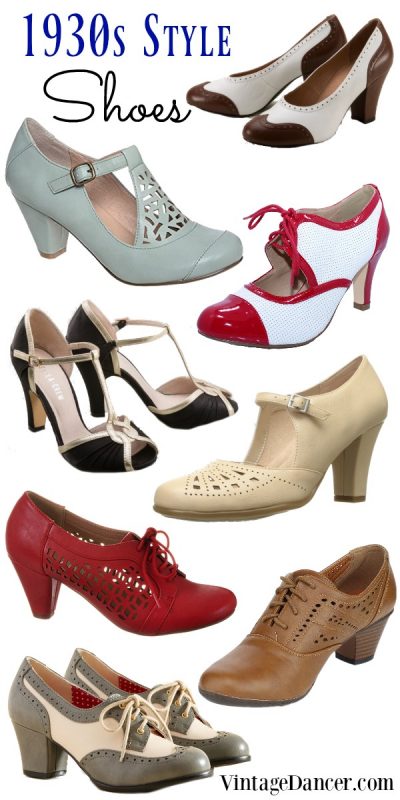
1930s Style Shoes. Shop here.
Lingerie in the 1930s
Lingerie went from practical to beautiful with new bias cut panties and cupped bras in pretty pastel hues. Shapewear in the form of corsets, all-in-ones, and girdles helped form the ideal linear silhouette while a silky slip smoothed out dress lines.
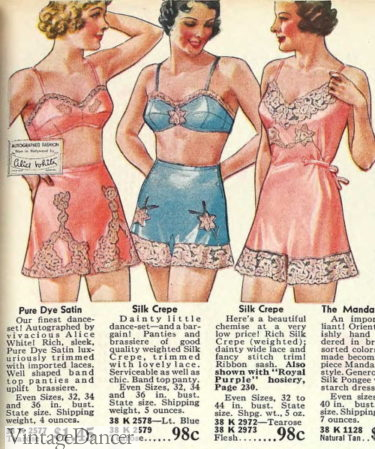
1936 lingerie sets
1930s stockings, held up with garters, were essential in all seasons. Colors were varied: white, black, navy blue, many shades of grey and taupe. In summer, a pair of white ankle socks worn with sport shoes or sandals, was a refreshing break.
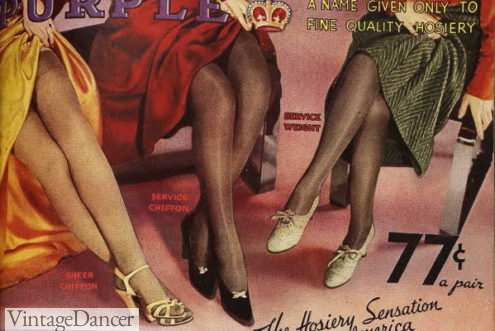
1934 stockings
At night, 1930s nightsgowns, pajamas and robes were as elegant as evening gowns. Silky sets trimmed in lace are the inspiration for most luxury sleepwear today.
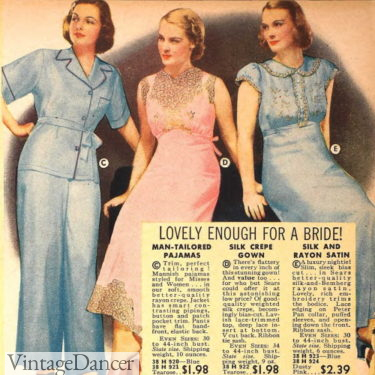
1938 rayon pajamas and nightgowns
Beauty in the 1930s- Hair and Makeup
In the 1930s, women attempted to cheer themselves up with pampering in the form of beauty products and hairstyling. Weekly visits to the salon were in order to set hair in the latest finger waves and tight rolls.
Short hair was in style (although long hair was acceptable), and it needed expert attention to cut and curl hair. At night, women would wash (about once a week) and set their own hair in rag curlers or use a marcel iron to create deep waves.
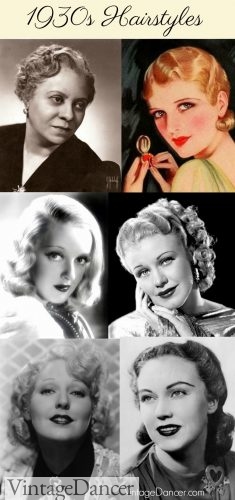
1930s Hairstyles for Short or Long, Curly or Waved Hair
Makeup was booming during this time. The new face was no longer full and doll-like but thin and streamlined. Eyebrows were arched high and thin. Lips were painted with soft pink tones to match the light peachy-blush on the cheeks. Eyes were exaggerated with long dark lashes and shimmering jewel tone shadows. Learn more about 1930s makeup.
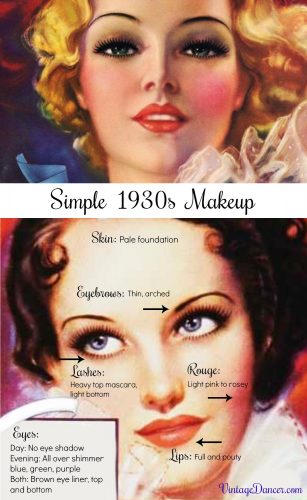
1930s Makeup Guide- Read more.
Hollywood 1930s Fashion
What else did women wear in the 1930s? For some, it was all about high fashion. Take a look at this 10 minute video about 1930s couture and Hollywood fashion history. The men’s video is also excellent.
Read more 1930s fashion history articles or move on to women’s 1940s fashion.
1930s Outfits
- 1930s Outfit Ideas for Women – Read this article for inspiration and outfit ideas.
- 1930s Outfit Inspiration & Women’s Clothing Ideas
- 1930s Summer Beach Outfits – Beach pajamas and swimwear.
- Plus size and mature women’s outfit inspiration.
- Try this one for menswear-inspired casual 20s-30s styles.
- Ready made 1930s costumes will also give you ideas such as Betty Boop, Bride of Frankenstein, Olive Oyl, and Bonnie Parker (gangster moll).
Shop 1930s Style Clothing
Dresses | Tops | Skirts | Pants | Coats | Shoes | Sewing patterns
Debbie Sessions has been teaching fashion history and helping people dress for vintage themed events since 2009. She has turned a hobby into VintageDancer.com with hundreds of well researched articles and hand picked links to vintage inspired clothing online. She aims to make dressing accurately (or not) an affordable option for all. Oh, and she dances too.
